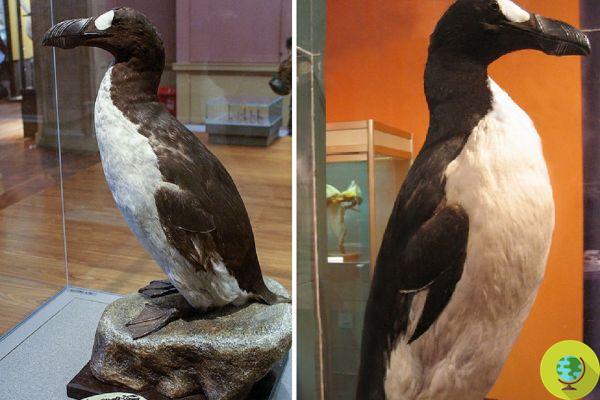
Great Auk, the bird that became extinct because of the man who completely exterminated it to obtain meat, eggs and feathers.
Have you ever heard ofAlca rampant? It is a flightless bird of the Alcidae family, the last of which was killed by fishermen in 1844.
The bird, very similar to penguins, dates back to 5 million years ago, and it is completely extinct in the mid-800s due to man, as has also been shown by research by ornithologists from various countries.
The research has in fact shown, thanks to the analysis of the mitochondrial DNA extracted from the bones of 41 samples, that their genetic wealth was high and that, therefore, the species had no problems of genetic drift before it was totally extinct. This supports the idea that it was man who decreed its end.
About the great Auk, what is known is that it measured almost a meter in height and weighed about 5 kg, had a black back and a white belly. The wings were too thin for the animal to fly.
Based on the information gathered, it would appear that they were excellent swimmers and that they used their wings to go underwater where they hunted fish. They could hold their breath for up to fifteen minutes and dive very deep. They had no large natural predators, except for killer whales, polar bears and eagles. Not as agile they were on the ground where, on the contrary, they were awkward and slow.
Regarding their relationship with humans, they weren't originally afraid of it, probably because their predators were very different from us. This is despite the fact that prehistoric humans certainly fed on them as bones of these birds were found in Neanderthal bonfires from 100.000 years ago. Among other things, Native Americans and Eskimos also ate them.
But the humans of that time did not represent a serious threat, the problems came when, much later, they reached them in the Northern Hemisphere where they lived in large numbers, concentrated in several European countries and in North America.
Sailors in fact began to kill them, as the explorer George Cartwright observed in 1785, and although they were numerous, hundreds of thousands, they were largely exterminated to obtain meat, fat, eggs to collect and especially feathers, much sought after at the beginning. of the XNUMXth century because they represented a good thermal insulator and were also light and easily compressible, as reported by ZMEScience. So on there was a systematic slaughter of these birds. Among other things, unfortunately, it was also very cruel because the poor animals were seized, deprived of feathers, and set on fire.
The last colony lived on the Geirfuglasker (the "Great Auk Rock") off the coast of Iceland, on an islet practically inaccessible to humans but a volcanic eruption submerged the island and the birds had to move to the nearby island of Eldey.
By now the great Auk was close to extinction and although the scientists of the time were aware of it, the species was destined to disappear. The last pair were found by two sailors who strangled the birds to deliver the bodies to a merchant and destroyed their egg.
Today there are only 78 skins of great Auk in museums and it is because of man that the species has become totally extinct. Their sad story should make us reflect and teach us not to make the same mistakes of the past, before it is too late for too many endangered species.
FONTI: Demographic reconstruction from ancient DNA supports rapid extinction of the great auk/ eLife – ZMEScience
You might also like:
- At risk of extinction as many as 600 species of animals more than expected. I study
- 10 animal species at risk of extinction


























